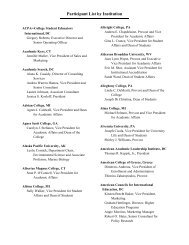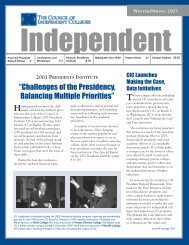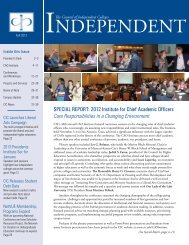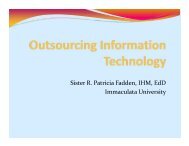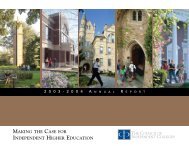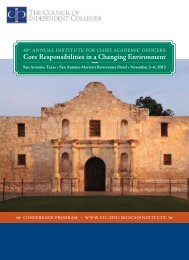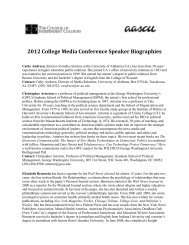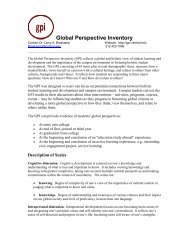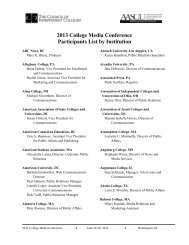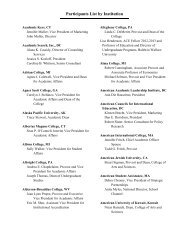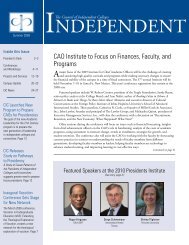Meeting the Challenge: - The Council of Independent Colleges
Meeting the Challenge: - The Council of Independent Colleges
Meeting the Challenge: - The Council of Independent Colleges
Create successful ePaper yourself
Turn your PDF publications into a flip-book with our unique Google optimized e-Paper software.
From Accreditation to Validation: CIC’s First Half-Century<br />
In 2005, <strong>the</strong> <strong>Council</strong> continued <strong>the</strong>se efforts with<br />
an updated approach: “Making <strong>the</strong> Case,” a dynamic website<br />
containing a collection <strong>of</strong> data-backed assertions about <strong>the</strong><br />
effectiveness <strong>of</strong> small and mid-sized independent colleges. As<br />
Richard Ekman has noted, “Coupling <strong>the</strong> rhetoric <strong>of</strong> claims<br />
for <strong>the</strong> distinctive effectiveness <strong>of</strong> smaller institutions with<br />
<strong>the</strong> growing supply <strong>of</strong> data that confirm <strong>the</strong> truth <strong>of</strong> this<br />
rhetoric seemed crucial when we began to develop <strong>the</strong> plans.”<br />
Organized under six principal messages with documentation<br />
in more than 100 tables and graphs, <strong>the</strong>se materials provide<br />
a strong argument for <strong>the</strong> benefits and effectiveness <strong>of</strong> CIC<br />
institutions to students and society.<br />
CIC’s Making <strong>the</strong> Case website (www.cic.edu/<br />
making<strong>the</strong>case/index.asp) provides detailed evidence that<br />
independent institutions:<br />
• Are Affordable for Students and Families—<br />
<strong>the</strong>y represent perceived value, provide financial<br />
assistance, and enable timely degree completion<br />
• Provide Access and Success for Diverse Students—<br />
<strong>the</strong>y educate students <strong>of</strong> color, students <strong>of</strong> all income<br />
levels, first-generation students, “at-risk” students, and<br />
non-traditional students<br />
• Provide Personal Attention to Students—<strong>the</strong>y encourage<br />
faculty-student interaction, <strong>of</strong>fer engaging classroom<br />
experiences, promote learning outside <strong>the</strong> classroom,<br />
facilitate participation in campus activities, and foster<br />
development <strong>of</strong> faith and values<br />
• Enable Student Success—<strong>the</strong>y lead to higher graduation<br />
rates and enable better preparation for life<br />
• Engender Alumni Satisfaction with Education—<br />
<strong>the</strong>y <strong>of</strong>fer quality education, represent a worthwhile<br />
investment, and encourage support for institutions<br />
• Involve Students and Alumni Contributing to <strong>the</strong><br />
Public Good—<strong>the</strong>y foster values and ethics, lead to<br />
higher graduation rates, encourage community<br />
involvement, and promote contributions to nonpr<strong>of</strong>its.<br />
1990<br />
CIC launches Information<br />
Technologies Workhops,<br />
held annually for 12 years.<br />
76



